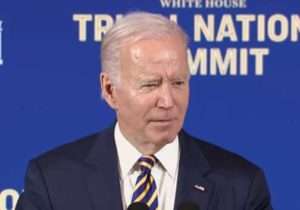
U.S. President Joe Biden drew enthusiastic applause from tribal leaders attending day one of a two-day White House Tribal Nations Summit in Washington, where Biden announced new policies for improving tribal consultation across federal agencies.
“Consultation has to be a two-way, nation-to-nation exchange,” he said. “Federal agencies should strive to reach consensus among the tribes, and there should be adequate time for ample communication.”
Tribes have long sought more inclusion in federal decision-making on policies in keeping with the U.S. Constitution and hundreds of treaties negotiated with the U.S. government between 1778 and 1871.
In 2019, however, the Government Accountability Office (GAO) found some federal agencies did not respect tribal sovereignty or tribes’ relationship with the government and failed to adequately consult tribes on infrastructure projects impacting tribal natural and cultural resources.
Biden announced he had signed a new memorandum of understanding (MOU), unifying consultation processes across the government agencies. It directs agency heads to keep public records on all consultations, summarizing all tribal concerns and recommendations and showing how tribal input is considered into the agency decisions.
Agency heads also must explain their reasoning if and when tribal suggestions are not incorporated into agency action.
“Tribal nations should know how their contributions influence the decision making,” Biden said, adding that the MOU will require all relevant federal agencies to participate in annual training on the tribal consultation process.
Managing environmental issues
Separately, U.S. Interior Secretary Deb Haaland announced several initiatives aimed at strengthening Washington’s relationship with 574 federally recognized tribes and boosting their sovereignty and economic development.
From wildfires and drought to the widespread loss of species and their habitats, climate change is “the challenge of our lifetime,” Haaland told tribal leaders attending the first in-person summit.
“If we are going to successfully overcome these threats, we must work together,” Haaland said.
To that end, the Commerce Department will join the Interior and Agriculture Departments by signing Joint Secretarial Order 3403. That order, issued in November 2021, is designed to ensure that federal agencies work with tribes to manage millions of hectares of federal lands, waters and wildlife.
“Today, the Departments of Interior and Agriculture are outlining a series of new steps to ensure tribes can participate in the stewardship of federal lands and waters,” Haaland said.
That includes, said Haaland, “producing a first of its kind report on the many existing legal authorities we have as agencies to advance co-stewardship with tribal nations as the United States works to honor our trust and treaty responsibilities to protect tribal sovereignty and revitalize tribal communities.”
Closing digital divide
A 2021 study by Arizona State University’s American Indian Policy Institute found that 18% of tribal reservation residents had no internet access and 33% were forced to rely on smartphones to access the internet.
Haaland announced that the Interior and Commerce departments will sign a memorandum of understanding with the Federal Communications Commission to better coordinate in promoting wireless services on tribal lands and give tribes a voice in developing national broadband policy.
The Interior Department also will establish a new Office of Indigenous Communication and Technology to help tribal nations and communities manage, develop and maintain broadband infrastructure, as well as forge partnerships with the tech industry.
“All of these new tools will help strengthen our nation-to-nation relationship while ensuring that communities have the tools — both new and old — to reach true self-determination and move toward a more prosperous era for Indian country,” Haaland said.
Documenting boarding school histories
Haaland also announced the Interior Department, with support from the National Endowment for the Humanities, will in 2023 begin work on a permanent oral history project to document the experiences of students in the federal Indian boarding school system.
Following the discovery in 2021 of more than 200 sets of remains on the grounds of the Kamloops Indian Residential School in Canada, the Interior Department launched the Federal Indian Boarding School Initiative to study the impact of these boarding schools on Native American attendees, descendants and their families.
The department released the first volume of findings in May, reporting that between 1819 and 1969, the federal government operated 408 federal schools in 37 states.
Investigators have so far identified more than 1,000 other federal and non-federal institutions involved in educating and assimilating Native American, Native Alaskan and Native Hawaiian children. These included day schools, orphanages and standalone dormitories.
They report that the schools used “systematic militarized and identity-alteration methodologies” in their effort to Americanize Native children, giving them English names, banning their languages, cultural and spiritual practices.
“The federal Indian Boarding School Initiative is about more than reliving the trauma of our past,” Haaland said in her announcement Wednesday. “It’s about making sure that survivors of these brutal federal policies are seen and heard and that their stories are told to future generations.”
Source: VOA
